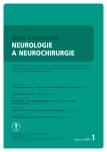Diagnostic Pitfalls of an Atypical Form of Congenital Muscular Dystrophy – Partial Merosin Deficiency – Case Reports
Authors:
A. Slabá 1; L. Fajkusová 2; K. Stehlíková 2; R. Barresi 3; M. Kynčl 4; J. Zámečník 5; J. Haberlová 1
Authors‘ workplace:
Klinika dětské neurologie 2. LF UK a FN Motol, Praha
1; Centrum molekulární biologie a genové terapie, FN Brno
2; University of Newcastle, Institute of Human Genetics, International Centre for Life, Newcastle upon Tyne, United Kingdom
3; Klinika zobrazovacích metod 2. LF UK a FN Motol, Praha
4; Ústav patologie a molekulární medicíny, 2. LF UK a FN Motol, Praha
5
Published in:
Cesk Slov Neurol N 2017; 80/113(1): 101-106
Category:
Case Report
doi:
https://doi.org/10.14735/amcsnn2017101
Tento článek vznikl za podpory nadace Pohyb bez pomoci.
Overview
Congenital muscular dystrophies are a group of inherited muscle disorders characterized by early onset of muscle weakness and dystrophic changes in muscle biopsy. Mutation of the laminin α2 gene resulting in total or partial merosin deficiency is the most common cause in European population. Total loss of merosin manifests as congenital muscular dystrophy type 1A, partial deficiency results in limb girdle weakness of variable severity. Diagnosis of partial deficiency is based on clinical manifestation, brain magnetic resonance imaging (MRI) with apparent leucodystrophy, electromyography with documented peripheral neuropathy and genetic examination, muscle MRI pattern of pathological changes may be beneficial in differential diagnosis. Muscle biopsy shows dystrofic changes but immunohistochemistry may not reveal merosin deficiency and so it can be misleading. Treatment is symptomatic, correct diagnosis can help in predicting the course of the disease and associated risks and facilitates genetic counselling. It is likely that, due to the difficult diagnosis, partial merosin deficiency occurs more frequently than currently estimated. The authors present three illustrative case reports.
Key words:
congenital muscular dystrophy – partial merosin deficiency – laminin α2 – leucodystrophy – peripheral demyelinating neuropathy – magnetic resonance imaging
The authors declare they have no potential conflicts of interest concerning drugs, products, or services used in the study.
The Editorial Board declares that the manuscript met the ICMJE “uniform requirements” for biomedical papers.
Chinese summary - 摘要
诊断困难先天性肌的非典型 营养不良 - 偏阴虚Merosin's - 病例报告摘要
先天性肌营养不良症是一组罕见的遗传性肌一个疾病的特点是困难和形象改变营养不良发病初期
肌肉活检。欧洲人口是最常见的原因基因的突变层粘连蛋白α2,从而导致降低或不存在的生产Merosin's。临床区分这两种表现型:完全赤字Merosin's,即先天性经典的表型。肌营养不良1A型,并与Merosin有条件局部不足的表型可变严重性带肌肉无力。诊断依据不足部分在临床情况,脑白质病变的磁共振成像发现脑肌电变化与周围神经病变的证据,遗传检查过程中检查,辅助技术可能会被削弱肌纹磁共振。肌肉活检是很明显的营养不良的变化免疫组化可能成为常态,使诊断常复杂。治疗主要是对症诊断允许课程的预测和风险和遗传咨询。由于诊断陷阱可能
Merosin's 的偏阴虚较成功的展会更常见。作为一个例子作者目前三个案例报告。
关键词:
先天性肌营养不良 - 偏阴虚Merosin - 层粘连蛋白α2 -脑白质营养不良 - 主要是外周脱髓鞘病变 - 磁共振成像
Sources
1. Reed UC. Congenital muscular dystrophy. Part I: a review of phenotypical and diagnostic aspects. Arq Neuropsiquiatr 2009;67(1):144 – 68.
2. Sparks S, Quijano-Roy S, Amy Harper A. Congenital muscular dystrophy overview. [accessed 2016 May 20]. Available from URL: http://www.ncbi.nlm.nih.gov/books/NBK1291.
3. Ciafaloni E, Chinnery PF, Griggs RC. Evaluation and treatment of myopathies. 2nd ed. Oxford, GB: Oxford University Press 2014.
4. Vajsar J, Kraus J. Kongenitální svalové dystrofie. Neurol Praxi 2012;13(4):195 – 7.
5. Graziano A, Bianco F, D’Amico A, et al. Prevalence of congenital muscular dystrophy in Italy: a population study. Neurology 2015;84(9):904 – 11. doi: 10.1212/ WNL.0000000000001303.
6. Clement EM, Feng L, Mein R, et al. Relative frequency of congenital muscular dystrophy subtypes: analysis of the UK diagnostic service 2001 – 2008. Neuromuscul Disord 2012;22 : 522 – 7. doi: 10.1016/ j.nmd.2012.01.010.
7. Miyagoe-Suzuki Y, Nakagawa M, Takeda S. Merosin and congenital muscular dystrophy. Microsc Res Tech 2000;48 : 181 – 91.
8. Kim HJ, Choi YC, Park HJ, et al. Congenital muscular dystrophy type 1A with residual merosin expression. Korean J Pediatr 2014;57(3):149 – 52. doi: 10.3345/ kjp. 2014.57.3.149.
9. Seeman P, Šišková D, Perníková I, et al. Kongenitální svalová dystrofie s úplným defektem merosinu – první dva případy prokázané v České republice – typický fenotyp a průkaz pomocí biopsie kůže. Cesk Slov Neurol N 2002;65/ 98(1):37 – 44.
10. Chan SH, Foley AR, Phadke R, et al. Limb girdle muscular dystrophy due to LAMA2 mutations: diagnostic difficulties due to associated peripheral neuropathy. Neuromuscul Disord 2014;24(8):677 – 83. doi: 10.1016/ j.nmd.2014.05.008.
11. Sewry CA, Naom I, D‘Alessandro M, et al. Variable clinical phenotype in merosin-deficient congenital muscular dystrophy associated with differential immunolabelling of two fragments of the laminin alpha 2 chain. Neuromuscul Disord 1997;7(3):169 – 75.
12. Straub V, Carlier PG, Mercuri E. TREAT-NMD workshop: pattern recognition in genetic muscle diseases using muscle MRI: 25 – 26 February 2011, Rome, Italy. Neuromuscul Disord 2012;22(Suppl 2):S42 – 53. doi: 10.1016/ j.nmd.2012.08.002.
13. Nelson I, Stojkovic T, Allamand V, et al. Laminin α2 Deficiency-Related Muscular Dystrophy Mimicking Emery-Dreifuss and Collagen VI related Diseases. J Neuromuscul Dis 2015;2(3):229 – 40. doi: 10.3233/ JND-150093.
Labels
Paediatric neurology Neurosurgery NeurologyArticle was published in
Czech and Slovak Neurology and Neurosurgery

2017 Issue 1
- Hope Awakens with Early Diagnosis of Parkinson's Disease Based on Skin Odor
- Memantine Eases Daily Life for Patients and Caregivers
- Metamizole vs. Tramadol in Postoperative Analgesia
- Memantine in Dementia Therapy – Current Findings and Possible Future Applications
- Current Insights into the Antispasmodic and Analgesic Effects of Metamizole on the Gastrointestinal Tract
Most read in this issue
- Essential Neurological Examination – Time for Change?
- Current Perception of Contraindications and Complications of Nerve Conduction Studies and Needle Electromyography
- Extirpation of Colloid Cyst by an Endoscopic Approach
- Periodic Limb Movements During Sleep are More Severe in Narcolepsy with Cataplexy than in Narcolepsy without Cataplexy
